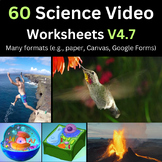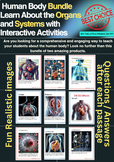219 results
Physics scaffolded notes for Microsoft Word
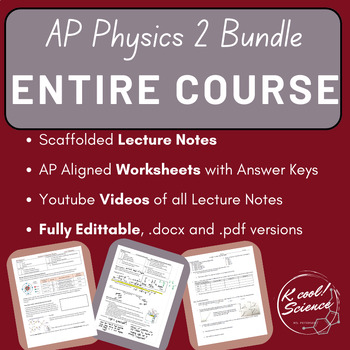
Entire AP Physics 2 Curriculum- Notes, Practices, and Video Lectures!
This bundle includes:Scaffolded Lecture Notes- designed to have space to write and annotate as the teacher lectures, writing along with the students as they go. These are developed from the Course and Exam Description, the Cutnell-Johnson textbook, AP Physics 2 prep books, Bigler Notes, and more to teach the content in a concise, straightforward, and effective manner.Practice Worksheets + KEYs- For each lecture, a matching practice where students extend and practice their skills in both AP level
Subjects:
Grades:
10th - 12th

Introduction to Work and Power Guided Notes and Practice Worksheet
Guided notes to accompany introduction PowerPoint (my primary free product!) and practice problems including solving for work and power, identifying when work is done, and a fill-in-the blank review section of vocab from work, power, force, etc.Designed to accompany: PowerPoint Introduction to work and power with examples and practice problemsNext lesson: 5.1 What is Energy powerpoint
Subjects:
Grades:
8th - 10th

Concept Compare: Kepler's (and Newton's) Laws of Planetary Motion for Orbits
This concept comparison is between: Kepler's Laws of Planetary Motion, and how they relate to Newton's Laws of Motion and the Law of Universal Gravitation. Bring a calculator!The Concept Comparison Routine is used help compare and contrast key concepts. Specifically, students use like and unlike characteristics and categories shared and not shared by two or more concepts to better understand the overall concept. Students taught using the Content Enhancement routines earned higher total test scor
Subjects:
Grades:
7th - 12th, Higher Education
NGSS:
HS-ESS1-4
Also included in: StayGiant Earth Science Bundle: Astronomy (space exploration)
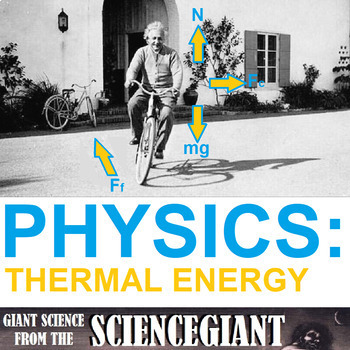
StayGiant Physics Bundle: Thermal Energy
Teachers use the Strategic Instruction Model (SIM) Framing Routine to transform abstract main ideas and key topics into a concrete representation that helps students think about and talk about the key topic and essential related information. SIM is about promoting effective teaching and learning of critical content in schools. SIM strives to help teachers make decisions about what is of greatest importance, what we can teach students to help them to learn, and how to teach them well.Personally,
Subjects:
Grades:
9th - 12th, Higher Education
NGSS:
MS-PS3-4
, HS-PS3-4
, MS-PS3-3
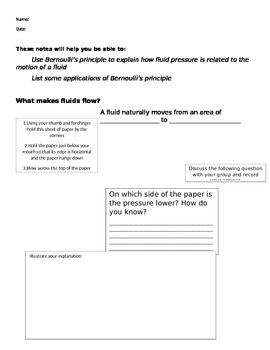
Bernoulli's & Pascal's Principle PowerPoint Notes
With this Powerpoint Note Taking guide your students will be able to:
1. Use Bernoulli's principle to explain how fluid pressure is related
to the motion of a fluid
2. Use Pascal's principle to explain how fluid pressure is applied
and transmitted
3. Identify and explain applications of Bernoulli's and Pascal's
principle.
4. Notes keep students on pace with powerpoint and are an
excellent tool to check for understanding with formative
asses
Subjects:
Grades:
7th - 12th
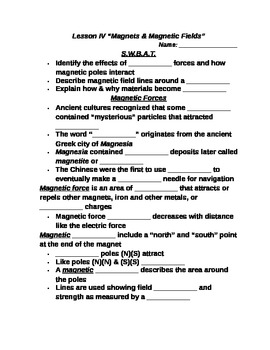
Lesson IV Student PowerPoint Note Guide "Magnets & Magnetic Fields"
This lesson aligns with the Common Core State Standards:
"STANDARD 5 - Matter and Energy
The competent science teacher understands the nature and properties of energy in its various forms, and the processes by which energy is exchanged and/or transformed.
5A. understands the atomic and nuclear structure of matter and the relationship to chemical and physical properties
5D. understands the characteristics and relationships among thermal, acoustical, radiant, electrical, chemical, mechanical, a
Subjects:
Grades:
7th - 9th
CCSS:

Concept Compare: Why Does the Sun Shine? Thermonuclear Fusion! (p-p and CNO)
This Concept Comparison of Thermonuclear Fusion contrasts proton-proton (p-p) chain reactions, and the "cold" carbon-nitrogen-oxygen (CNO) cycles. Help Ss communicate scientific ideas about the way stars produce elements over their life cycle. Emphasis is on the way nucleosynthesis, and therefore the different elements created, varies as a function of the mass of a star and the stage of its lifetime. As cosmologist Carl Sagan famously said, “We are made of star stuff.” And we literally are! We a
Subjects:
Grades:
8th - 12th, Higher Education
NGSS:
HS-PS1-8
, HS-ESS1-3
, HS-ESS1-1
Also included in: StayGiant Earth Science Bundle: Astronomy (space exploration)
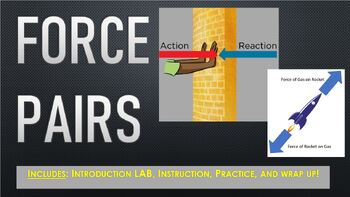
Force Pairs Lesson
This resource (Lesson 3 of my Energy and Motion Unit Bundle) includes everything you need to introduce, instruct, practice, and wrap up Newton's 3rd Law of Motion - force pairs - for each action, there is an equal and opposite reaction force. The introduction activity is a fun and engaging lab in which students can interact with the forces that make a balloon rocket go. All teacher prep is included Save $3 by getting the Energy and Motion Unit bundle in my store, which includes the following:1.
Subjects:
Grades:
6th - 10th
NGSS:
MS-PS2-1
Also included in: Force and Motion BUNDLE

StayGiant Physics Bundle: Electricity
Electric Charge, Electric Force, and DC CircuitsSs begin an exploration of electricity by learning about the electric force and the properties and interactions of electric charges. Ss continue by examining electric circuits and the interactions between current, resistance, and voltage.Topics include:Conservation of chargeElectric chargeElectric forceDefinition of a circuitResistivityOhm’s law, Kirchhoff’s loop rule (resistors in series and parallel)Kirchhoff’s junction rule, Ohm’s law (resistors
Subjects:
Grades:
8th - 12th, Higher Education
NGSS:
MS-PS3-2
, HS-PS3-1
, HS-PS3-5
, 4-PS3-2
, HS-PS3-3
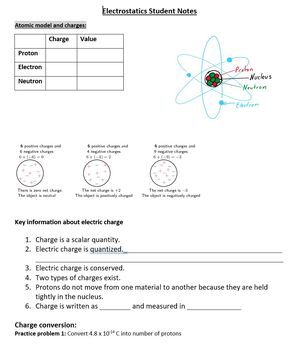
Electrostatic Student and Teacher Notes
This Document contains student and teacher notes on Electrostatics leading to Current Electricity. This can be used as a stand alone resource but is recommended to use with the chapter PowerPoint.The following topics are covered in simple language to help students grasp the complicated concepts:•Charges and properties of charges•Conductors and insulators•Electrostatic Force•Coulomb’s law•Methods of charging•Electric field•Electric potential energy•Electric potential and VoltageThe notes also inc
Subjects:
Grades:
9th - 12th
Types:
Also included in: Electrostatics
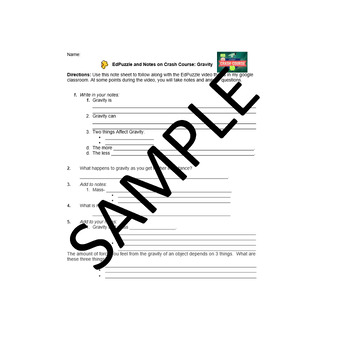
Crash Course Gravity EdPuzzle Note Sheet
· This note sheet is great to use as a warm-up, quick notes, or self-paced with a substitute. · This note sheet only covers the first 4 minutes of the Crash Course Gravity Video. After that point he gets more advanced than my 7th grade students need. Here is the link to my EdPuzzle Lesson that goes with these notes. The EdPuzzle will prompt them to write notes and fill in answers to the questions as they watch.
Subjects:
Grades:
6th - 8th
Types:
NGSS:
MS-ESS1-2
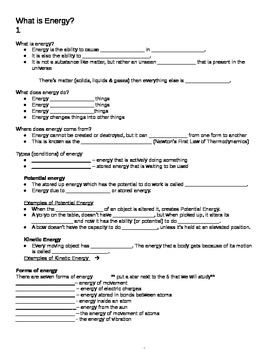
Guided Notes for Energy Powerpoints
The following fill in the blank notes are to be printed and used while presenting the Kinetic and Potential Energy, The Forms of Energy and Energy Transformations powerpoint lesson. Students will fill in the blank with the correct word from the presentation. This keeps students on task during note taking or lectures. South Carolina State Standard 6-5
Subjects:
Grades:
5th - 7th
Types:
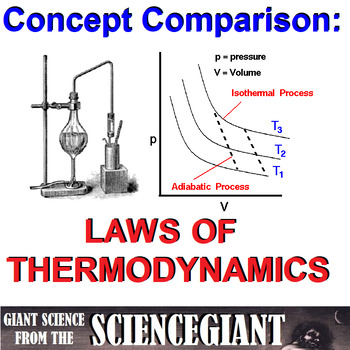
Concept Comparison Frame: Laws of Thermodynamics
What are Laws of Thermodynamics? This concept comparison introduces Ss to the laws of the thermodynamics, pressure-volume diagrams for ideal gases, processes which are isothermal, isovolumetic, and adiabatic, and explains differences in enthropy and enthalpy. Through inquiry and exploration, students will describe how the law of conservation of energy dictates how heat energy is transferred through systems by convection, conduction, and radiation, its influences on changes of states of matter an
Subjects:
Grades:
9th - 12th, Higher Education
Types:
NGSS:
MS-PS3-4
, HS-PS3-4
, HS-PS3-2
, MS-PS3-3
Also included in: StayGiant Physics Bundle: Thermal Energy

Reading to Learn - Introduction to Magnetism - Introductory Physics
This reading introduces the idea of magnetism. Students are provided short paragraphs about magnetism, ample space to interact with the text with circling / boxing / underlining key ideas, and then reading comprehension questions after the text. These questions aid in slowing students down in their reading and to interact further with the text. Students need to pull evidence from the text for reading comprehension questions and make inferences about terms used in the reading passage.This is a
Subjects:
Grades:
4th - 7th
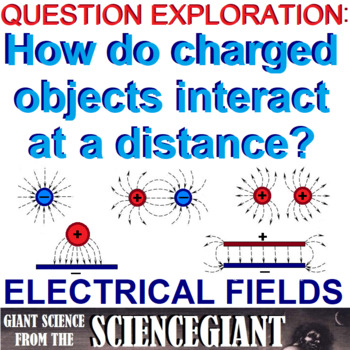
Question Explore: Electric Field Strength and How Charged Objects Interact
How do electrically charged object interact at a distance? This Question Exploration explains to Ss how an electric field exists around any charged unit. The field produces forces on other charged objects. This question exploration helps provide a picture of the electric field strength, and how charged objects interact at a distance.Question Exploration Routines are an instructional method that teachers can use to help a diverse student population understand a body of content information by care
Subjects:
Grades:
9th - 12th, Higher Education
NGSS:
MS-PS2-3
, HS-PS2-4
, MS-PS2-5
Also included in: StayGiant Physics Bundle: Electricity
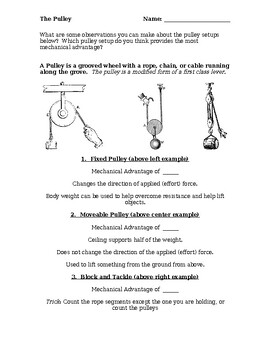
Physics: The Pulley Guided Student Notes (Fixed, Moveable, Block & Tackle)
This MS-Word handout helps guide a lesson on pulleys as part of a physics simple machine unit or Rube Goldberg project. Two levels of guided student notes are provided, the first for limited note taking for special needs students, and the second for typical students who can take full lesson notes. Since this is a word document, you can modify the level of detail you want students to take or fill-in. This is a great handout to use as a lesson exit ticket. The entire handout is can be previewe
Subjects:
Grades:
7th - 10th
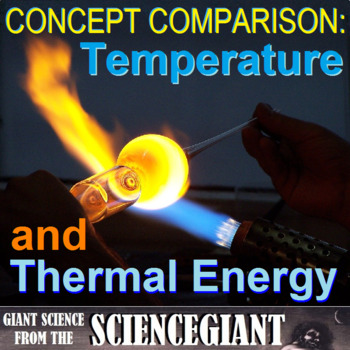
Concept Comparison: Temperature vs Thermal Energy
This Concept Comparison contrasts thermal energy and temperature as they relate to heat transfer. It builds from middle school science concepts of mechanical energy, and an introduces specific heat capacity and the laws of thermodynamics.The Concept Comparison Routine is used help compare and contrast key concepts. Specifically, students use like and unlike characteristics and categories shared and not shared by two or more concepts to better understand the overall concept. Students taught using
Subjects:
Grades:
7th - 12th, Higher Education
NGSS:
HS-PS1-4
, MS-PS1-4
, HS-PS1-5
, MS-PS1-6
Also included in: StayGiant Physics Bundle: Thermal Energy
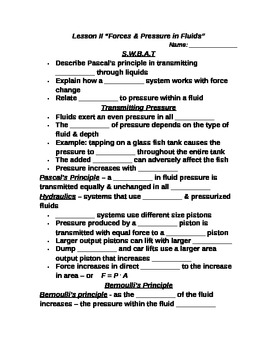
Lesson II Student PowerPoint Note Guide "Forces & Pressure in Fluids"
This lesson aligns with the Common Core State Standards:
"STANDARD 6 - Force and Motion
The competent science teacher understands and applies the concepts that describe force and motion and the principles that explain them.
6B. understands the concepts and interrelationships of force (including gravity and friction), inertia, work, power, energy, and momentum
6I. demonstrates abilities to use instruments or to explain functions of the technologies used to study force and motion."
Student not
Subjects:
Grades:
7th - 9th
CCSS:
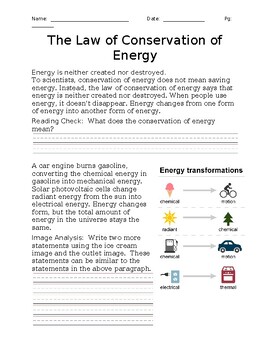
Reading to Learn Physics / Science - The Law of Conservation of Energy - Basic U
This reading introduces the law of conservation of energy. This nonfiction text provides students another opportunity to practice their reading to learn skills. Each paragraph is followed by a reading comprehension question to slow students down in their reading and to interact with the text. pulling evidence from the text for reading comprehension questions, analyzing an image and stating an energy transformation into words, and thinking about energy efficiency. This is a great resource to
Subjects:
Grades:
4th - 7th
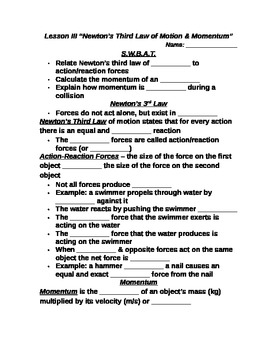
Lesson III Student PowerPoint Note Guide "Newton's Third Law & Momentum"
This lesson aligns with the Common Core State Standards:
"STANDARD 6 - Force and Motion
The competent science teacher understands and applies the concepts that describe force and motion and the principles that explain them.
6B. understands the concepts and interrelationships of force (including gravity and friction), inertia, work, power, energy, and momentum
6G. describes the effects of gravitational, electromagnetic, and nuclear forces in real life situations."
Student note guide or "fill in
Subjects:
Grades:
7th - 9th
CCSS:

StayGiant Physics Bundle: Impulse and Momentum
Teachers use the Strategic Instruction Model (SIM) Framing Routine to transform abstract main ideas and key topics into a concrete representation that helps students think about and talk about the key topic and essential related information. SIM is about promoting effective teaching and learning of critical content in schools. SIM strives to help teachers make decisions about what is of greatest importance, what we can teach students to help them to learn, and how to teach them well.Personally,
Subjects:
Grades:
9th - 12th, Higher Education
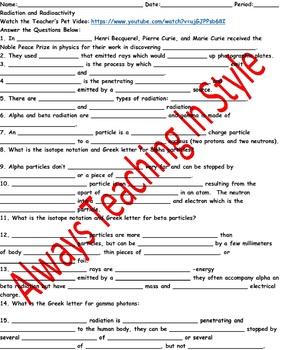
Radiation and Radioactivity Video Worksheet (Editable)
Here is an introduction worksheet to Radiation and Radioactivity video from Teacher's Pet (video link is embedded at the top of the worksheet). There are thirty-six questions that go along with the video. There is one HOT activity which is a comic strip that asks students to do extra research on one of the three types of radiation they learned about, and make a comic strip explaining that type of radiation. Along with the activity is a rubric to help grade the students.
This worksheet can be u
Subjects:
Grades:
6th - 12th
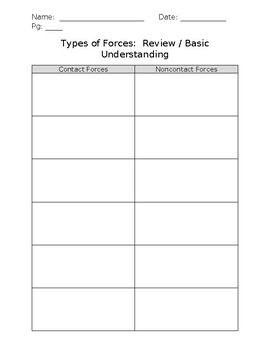
Review / Introduction of Types of Forces - Physics / Science - Basic Understandi
This activity introduces the idea of two types of forces: contact forces and noncontact forces. Students cut out terms and attempt to sort them into two categories: contact forces and noncontact forces. This allows the teacher to determine for whom this is a review and for whom these are new concepts. If students need background knowledge, a short reading is provided to provide information. Each paragraph is followed by a reading comprehension question to slow students down in their readi
Subjects:
Grades:
4th - 7th
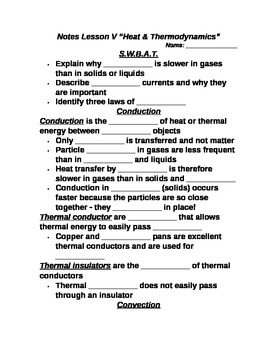
Lesson V Student PowerPoint Note Guide "Heat & Thermodynamics"
This lesson aligns with the Common Core State Standards:
"STANDARD 5 - Matter and Energy
The competent science teacher understands the nature and properties of energy in its various forms, and the processes by which energy is exchanged and/or transformed.
5D. understands the characteristics and relationships among thermal, acoustical, radiant, electrical, chemical, mechanical, and nuclear energies
5F. explains conservation of mass and energy and explains interactions of energy with matter, inclu
Subjects:
Grades:
7th - 9th
CCSS:
Showing 1-24 of 219 results

